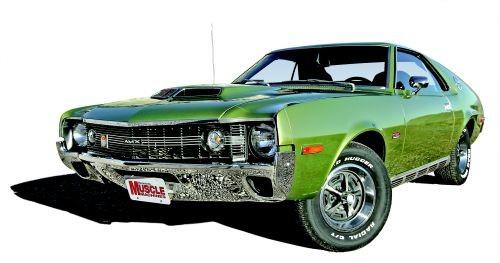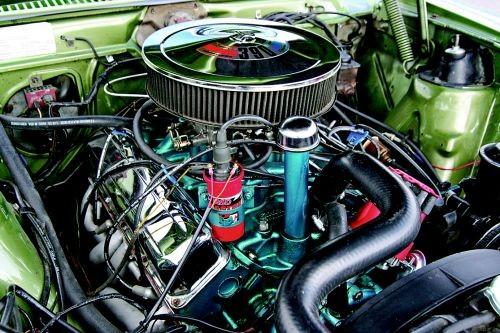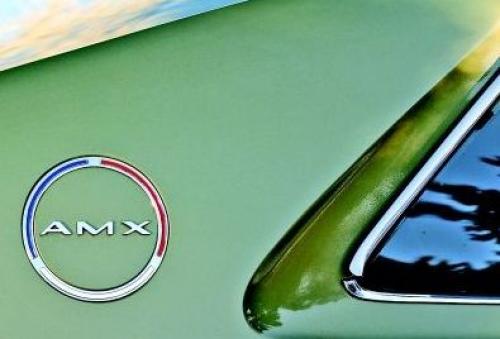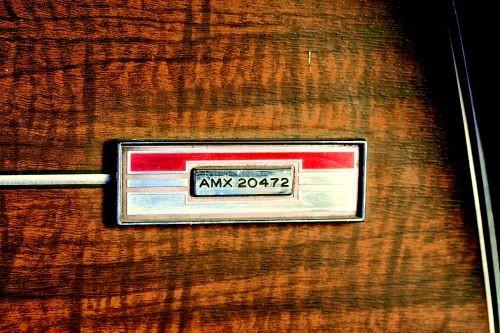FEATURE ARTICLE from Hemmings Muscle Machines
1970 AMC AMX
Hemmings Muscle Machines - JANUARY 1, 2007 - BY DANIEL STROHL
Nothing like it had ever come out of Kenosha before, and nothing like it would ever come out of there again.
While AMC was no slouch in its ability to offer high-performance
V-8-powered cars, most car buyers in the 1960s saw the company as being
focused on economy and thriftiness, not on flashy displays of power.
But on the heels of the Mustang's stunning success, AMC, like every
other American manufacturer at the time, was forced to recognize that
small, sporty cars had a place on dealer lots, not just on the showroom
turntables. Sure, doctors and lawyers could buy Corvettes and
Thunderbirds all day long, but now college students and secretaries
could look forward to driving something with a little more guts than
the average family sedan.
So, for a brief span of about five years, AMC totally devoted
itself to capturing the youth market. AMC first responded in September
1967 with the Javelin. Given the pony car-mad public, they knew it
would sell, but with Dick Teague's urging, the company decided to go
one step further with the AMX in February 1968, the only mass-produced
American two-seat sports coupe aside from the Corvette, and at $3,245,
more than $1,000 less expensive than its honored competitor.
A lot of people saw the AMX as a 12-inch shorter derivative of the
Javelin, given the shared body panels and chassis. Yet AMC engineers
and stylists designed both the AMX and the Javelin on separate tracks
at the same time. By February 1968, with concept versions of both
vehicles running the show circuit, AMC decided on the single platform
for the production versions of both cars.
Despite the buzz about the new AMX, AMC management didn't see the
point of the effort and expense behind building two different sports
cars, even if they shared most of their components. Midway through
1968--not too long after the AMX's introduction, mind you--management
decided to cancel the two-seater body style after the 1970 model year
and make the AMX a four-seater on the longer Javelin body. Declining
sales also ostensibly factored into the decision. Sales in the
shortened 1968 model year totaled 6,725, while 1969's amounted to
8,293. The 1970 figures dropped by half to 4,116.
Today, the two-seater AMX retains a vaunted spot among AMC fans,
more so than the later versions. Unique versions, such as the
Hurst-built SS/AMXs and the California 500 Specials, remain highly
sought after, but at times it seems nearly every one of the 19,134 that
AMC built during those three years remains in circulation and in
demand, ensuring a good future for the first-generation AMX as a
collectible muscle car.
ENGINES

AMC didn't release the third iteration
of its thin-wall V-8s--the 390--until the AMX debuted. In fact, AMC
tied the car and the engine so closely together that the engine became
known as the "AMX 390," despite the engine's placement in other AMC
models.
That engine, available as an option in only the four-barrel (315hp,
X-code) version, was one of three available in the AMX in 1968, all
V-8s. The other two, the 290 (235hp, N-code) and the 343 (280hp,
T-code), came exclusively with four-barrels. In 1969, the 290 dropped
10hp and AMC dropped the two-barrel 390.
Major changes came to the engine lineup in 1970, when the 290 and
the 343 both increased in stroke to become the 304 and the 360. The
former didn't make it into the AMX's engine bay from the factory, but
the latter, with a four-barrel (290hp, P-code), did. The 390 remained
through the 1970 model year, now with 325hp, still the X-code.
Internally, the three engines differed vastly. The 290 and 304 used
small intake and exhaust valves, thin block webbing and cast
crankshafts. The 343 and 360 used larger valves, thicker block webbing
and cast crankshafts. The 390 (and later the 401) used the larger
valves, thicker block webbing and forged steel crankshafts. The 1970
190 and the 1971 401 have the most sought-after AMC V-8 heads, with
their 51cc combustion chambers.
Probably just as important are the engines that never made it under
the hood of a two-seater AMX from the factory: six-cylinders, the Rebel
Machine's 340hp 390 and the 401. Also, all the AMX engines are of AMC's
own design, so AMC never used a Ford 390.
All AMC engines appear the same externally, save for numbers cast
on either side of the block, under the engine mount, denoting the
engine's displacement. Casting numbers and the small tag screwed to the
valve cover help identify the date an engine was built, but according
to Eddie Stakes, who offers AMX parts through his Web site, planethoustonamx.com,
AMC engines contain no identification that directly corresponds to the
car that AMC installed them in, "so it is virtually impossible to
determine whether a particular engine was originally installed in a
particular vehicle."
Jeff Reeves, the technical editor for American Motors Owners club,
said the most commonly known drawback to the AMC V-8 engines is the
oiling system, which restricts oil flow during extreme situations such
as drag racing. A widely publicized modification to the oiling system
helps relieve that problem.
TRANSMISSIONS
AMC made the Borg-Warner T-10
four-speed the base transmission for AMXs from 1968-1970. Every AMX
from January 1969-on ordered with the T-10 automatically came with a
Hurst shifter. AMC made three different gear ratio sets available in
the T-10s, all identified by the tag attached to the rear of the case.
The T-code used a wide-ratio gearset with a 2.64 first gear, the P-code
used a close-ratio set with a 2.43 first and the V-code used a
close-ratio set with a 2.23 first.
Borg-Warner also supplied the Shift-Command three-speed automatic
transmission, model M-11B or M-12, with either a column or floor
shifter. While AMC used aluminum-case versions behind its 290 and 304
engines in other models, every AMX automatic--even when behind the
290--had the cast-iron version. Reeves said the Borg-Warner automatic
wasn't a bad transmission, "but people don't like it because it can't
be modified performance-wise." In 1972, AMC switched from Borg-Warner
automatics to Chrysler TorqueFlites across its product range. "The
TorqueFlite can be modified all over the place for performance," Reeves
said. "If you weren't a drag racer, though, the B-W auto was a fine
transmission."
DIFFERENTIAL
The Model 20, an AMC design with
an 87/8-inch ring gear, enjoyed a long life under Kenosha cars--it was
used through the end of AMC V-8 production in 1979. AMC engineers made
it simple to identify the axle ratio inside the pumpkin by stamping one
of four codes from the factory on the differential housing cover
flange. An A-code refers to a 3.53:1 gear ratio, B-code to a 3.15,
C-code to a 2.87 and a D-code to a 3.91. Stakes said that dealers
offered four additional gear ratios: 3.73:1, 4.10:1, 4.44:1 and 5.00:1.
AMC made a limited-slip differential, called the Twin-Grip, available
as an option. Apparently, nothing apart from the build sheet can
identify a Twin-Grip-equipped car.
Reeves said Model 20s "are hamstrung by the splined hubs on the
ends of the axle shafts. If kept properly torqued, these axles can take
a good bit of extreme abuse, but most serious performance drivers
replace the splined shafts with solid one-pieces units."
CHASSIS
The AMX shared its general chassis
layout with the Rambler American and the Javelin--a unibody floorpan,
coil-spring front suspension and parallel-leaf rear suspension. For
1968 and 1969, trunnions located the front suspension rather than ball
joints. While trunnions offered reliable service as long as the car's
owner kept them greased, lack of lubrication severely decreased their
lifespan, so for 1970, AMC replaced the trunnions in the AMX and
Javelin with a ball-joint, upper-and-lower control-arm suspension
similar to the early Mustang's, with the coil spring above the upper
control arm and a trailing strut rod to locate the lower control arm.
Reeves said the biggest advantage to the ball-joint suspension is the
wider parts availability versus the trunnion suspension. In the rear,
AMC installed torque links that stiffened the rear suspension on hard
launches. All AMXs came standard with 10-inch drum brakes front and
rear, but four-piston 11-inch front disc brakes came as part of the Go
Package.
BODY & INTERIOR
 Some of the most
sought-after options for 1968-'70 AMXs are the three Big Bad colors. In
January 1969, AMC introduced Big Bad Orange, Big Bad Green and Big Bad
Blue as optional paints on the AMX and Javelin, covering even the
bumpers. While only a $34 option in 1969, the loud paint schemes didn't
sell too well--just 284 AMXs in 1969 had Big Bad Orange paint, 283 Big
Bad Green and 195 Big Bad Blue. The colors returned for 1970, but the
bumpers remained chrome that year; 114 AMXs in 1970 had the Big Bad
Blue paint, 74 had Big Bad Green and 122 had Big Bad Orange. AMC did
add another paint scheme in 1970, commonly called "shadow mask," that
incorporated a satin black-painted hood and window surrounds, offset by
silver striping, applied over any of the regularly available colors
that year. The shadow mask paint scheme appeared on 982 AMXs that year.
Each Big Bad color had its own paint code on the door trim tag, and the
shadow mask had a "-8" suffix to the car's regular paint code. Some of the most
sought-after options for 1968-'70 AMXs are the three Big Bad colors. In
January 1969, AMC introduced Big Bad Orange, Big Bad Green and Big Bad
Blue as optional paints on the AMX and Javelin, covering even the
bumpers. While only a $34 option in 1969, the loud paint schemes didn't
sell too well--just 284 AMXs in 1969 had Big Bad Orange paint, 283 Big
Bad Green and 195 Big Bad Blue. The colors returned for 1970, but the
bumpers remained chrome that year; 114 AMXs in 1970 had the Big Bad
Blue paint, 74 had Big Bad Green and 122 had Big Bad Orange. AMC did
add another paint scheme in 1970, commonly called "shadow mask," that
incorporated a satin black-painted hood and window surrounds, offset by
silver striping, applied over any of the regularly available colors
that year. The shadow mask paint scheme appeared on 982 AMXs that year.
Each Big Bad color had its own paint code on the door trim tag, and the
shadow mask had a "-8" suffix to the car's regular paint code.
The 1970 AMXs also received a slight redesign, with new taillamps
and a restyled front end that shared more styling cues with the Javelin
than in the previous two years. Overall length thus increased about two
inches. A prominent power blister, stamped into the hood, appeared this
year and its two huge nostrils could be opened up to become a ram-air
induction system when customers ordered the Go Package.
According to Stakes, AMXs and Javelins have three major areas known
to rust due to the engineering of the body panels: quarter panels,
especially on either side of the trunk, due to debris build-up; the
sill panels between the trunk lid and the rear window; and the lower
portion of the A-pillars, due to tiny drain holes that quickly filled
up with debris. He also notes the floor pans, the trunk pans and the
troughs under the front fenders as other potential problem areas.
 Inside, AMC affixed a small plate with a serial number to the
glovebox door or to the center of the dash. Research has shown that the
serial numbers did not coincide with the car's serial number, with
actual production order or with any other identifying number on the
car. In fact, the first 550 AMXs didn't come with a serial number, and
AMC reserved the first 50 serial numbers for special customers:
athletes, politicians and other celebrities. Nobody took AMC up on that
offer. Inside, AMC affixed a small plate with a serial number to the
glovebox door or to the center of the dash. Research has shown that the
serial numbers did not coincide with the car's serial number, with
actual production order or with any other identifying number on the
car. In fact, the first 550 AMXs didn't come with a serial number, and
AMC reserved the first 50 serial numbers for special customers:
athletes, politicians and other celebrities. Nobody took AMC up on that
offer.
AMXs shared their interiors with the Javelin--including bucket-only
seating--from the front seats forward. Behind that, the interior
quarter trim pieces are unique to the AMX. The armrests pose a large
problem area--their plastic covers curl up at the ends and their
mounting tabs are prone to breaking. Reeves said headliners posed the
biggest problem in 1968-1969 AMXs. "They were made of a flimsy material
that would tear loose and fall with little urging." A fiberglass
shell-type headliner is the most common replacement nowadays.
Build sheets usually appear in the back portion of the passenger
seat, but have also appeared under the carpet, behind door panels or
even on the other side of the headliner.
RESTORATION PARTS
The first-generation AMX
remains probably the most-supported AMC in terms of restoration parts.
The advantage, of course, comes through the parts that the AMX shared
with the Javelin and even with the Rambler American. Reproduction parts
have started to enter the market over the last several years, most
notably from Kennedy American and American Parts Depot, both located in
Ohio. The armrests noted above are available in reproduction through
Mick McNeice of Kilbride, Ontario.
NOS items do still exist, though typically not from dealers--when
Chrysler bought AMC in 1987, Lee Iacocca ordered many former AMC
dealerships to bulldoze their remaining AMC parts. However, some
dealerships either refused or went out of business before the Chrysler
purchase, allowing their NOS parts to remain on the market. Those
supplies have started to dwindle in recent years, causing an upswing in
prices, but restorers can still find grilles, interiors and trim if
they know where to look.
Stakes said the lack of parts should not detract potential AMX
buyers from the brand. "Yes, there is an AMC parts crisis," he said.
"No, you should not be intimidated by any of it, as it is part of the
fun of owning something different. You will find that AMC people are
more than helpful with any sort of advice, questions, tech, anything.
All you have to do is ask."
PERFORMANCE PARTS
AMC actually produced a line
of its own performance parts in the late 1960s, called the Group 19
parts after the section of the AMC parts catalog they occupied,
available only from dealerships at the time. The most well-known of
these parts, the Edelbrock-supplied R4B intake manifold, came in
aluminum and in a high-riser design, but AMC also listed the Edelbrock
cross-ram dual-quad intake manifold (the STR 11, commonly seen on
SS/AMXs), a Holley three-barrel carburetor (two primaries and one large
secondary instead of two divided secondaries) to replace the Carter
AFB, forged connecting rods, a forged steel crankshaft, a
high-performance camshaft, a Mallory dual-point distributor and even
headers.
These parts have become, understandably, about as rare or even
rarer than the NOS parts, but Edelbrock still offers an intake manifold
in its Performer line (though different from the R4B); several
companies offer stronger crankshafts and stroker kits; fiberglass
hoods, trunklids, doors and bumpers; and Indy Cylinder Head has even
recently introduced an all-aluminum AMC 401 block to go along with its
aluminum heads. In fact, the number of AMC performance parts available
seems to grow every year now as enthusiasts from the Big Three makes
start to realize that AMCs can be built to run alongside any other
muscle car.
Owner's View
Deb and Don Daleske, of Littleton,
Colorado, said they've been into AMCs since the mid-1970s, when they
realized that not only did AMCs cost less than other cars, but were
easier to work on as well.
"I tried working on Chryslers, and I dabbled in all the other
brands," Don said. "But I stuck with AMCs because I just like the cars,
and I thought they were well-engineered in their day.
"I also love two-seaters. I came close to buying a Corvette once,
but I backed out of that deal and started looking for an AMX. I found a
Javelin and a Hornet and bought them both, but didn't find a two-seater
AMX until 2001, when I found this one in some guy's backyard. He was
using it as a parts car for his other AMXs, so when I wanted to buy it,
he agreed to sell it with all the parts.
"We weren't going to restore it right away at first--I was going to
do it gradually--but I liked the car too well to let it sit, so
eventually we decided to go all out and we finished the restoration in
18 months."--Daniel Strohl
Values
| Year |
Low |
Average |
High |
| 1968 |
$6,500 |
$15,000 |
$24,500 |
| 1969 |
$6,500 |
$15,000 |
$24,500 |
| 1970 |
$7,000 |
$15,000 |
$26,000 |
Parts Prices
Timing cover (set): $259
Window cranks (each): $15
Bucket seat trim: $50
Weather seal kit: $340
Go-Package stripes: $169
Complete carpet kit: $265
Transmission mount: $15
Fiberglass fan shroud: $90
Grille emblem: $23
Headlamp switch: $30
Turn signal lens: $35
Speedometer cable: $45
Dual exhaust system: $349
Manual shifter boot: $39
Brake rotor (each): $129
This article originally appeared in the JANUARY 1, 2007 issue of Hemmings Muscle Machines.
Order Backissues of Hemmings Muscle Machines Here.
|



 Some of the most
sought-after options for 1968-'70 AMXs are the three Big Bad colors. In
January 1969, AMC introduced Big Bad Orange, Big Bad Green and Big Bad
Blue as optional paints on the AMX and Javelin, covering even the
bumpers. While only a $34 option in 1969, the loud paint schemes didn't
sell too well--just 284 AMXs in 1969 had Big Bad Orange paint, 283 Big
Bad Green and 195 Big Bad Blue. The colors returned for 1970, but the
bumpers remained chrome that year; 114 AMXs in 1970 had the Big Bad
Blue paint, 74 had Big Bad Green and 122 had Big Bad Orange. AMC did
add another paint scheme in 1970, commonly called "shadow mask," that
incorporated a satin black-painted hood and window surrounds, offset by
silver striping, applied over any of the regularly available colors
that year. The shadow mask paint scheme appeared on 982 AMXs that year.
Each Big Bad color had its own paint code on the door trim tag, and the
shadow mask had a "-8" suffix to the car's regular paint code.
Some of the most
sought-after options for 1968-'70 AMXs are the three Big Bad colors. In
January 1969, AMC introduced Big Bad Orange, Big Bad Green and Big Bad
Blue as optional paints on the AMX and Javelin, covering even the
bumpers. While only a $34 option in 1969, the loud paint schemes didn't
sell too well--just 284 AMXs in 1969 had Big Bad Orange paint, 283 Big
Bad Green and 195 Big Bad Blue. The colors returned for 1970, but the
bumpers remained chrome that year; 114 AMXs in 1970 had the Big Bad
Blue paint, 74 had Big Bad Green and 122 had Big Bad Orange. AMC did
add another paint scheme in 1970, commonly called "shadow mask," that
incorporated a satin black-painted hood and window surrounds, offset by
silver striping, applied over any of the regularly available colors
that year. The shadow mask paint scheme appeared on 982 AMXs that year.
Each Big Bad color had its own paint code on the door trim tag, and the
shadow mask had a "-8" suffix to the car's regular paint code.  Inside, AMC affixed a small plate with a serial number to the
glovebox door or to the center of the dash. Research has shown that the
serial numbers did not coincide with the car's serial number, with
actual production order or with any other identifying number on the
car. In fact, the first 550 AMXs didn't come with a serial number, and
AMC reserved the first 50 serial numbers for special customers:
athletes, politicians and other celebrities. Nobody took AMC up on that
offer.
Inside, AMC affixed a small plate with a serial number to the
glovebox door or to the center of the dash. Research has shown that the
serial numbers did not coincide with the car's serial number, with
actual production order or with any other identifying number on the
car. In fact, the first 550 AMXs didn't come with a serial number, and
AMC reserved the first 50 serial numbers for special customers:
athletes, politicians and other celebrities. Nobody took AMC up on that
offer.